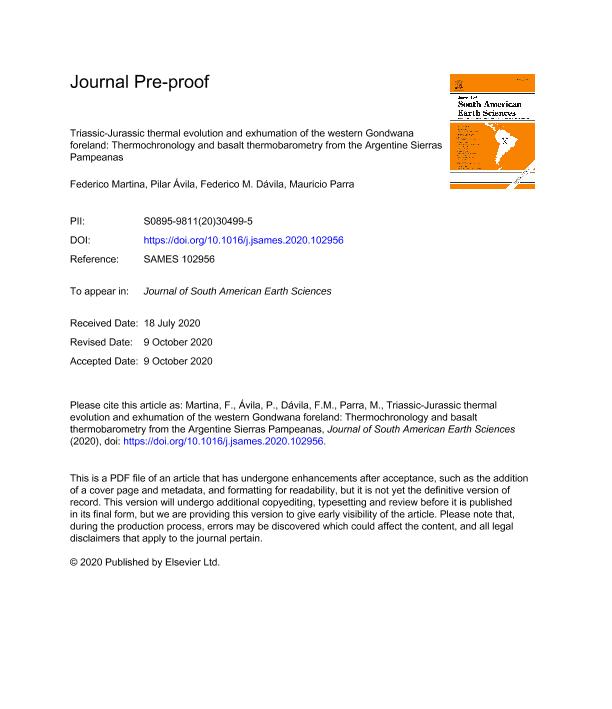Mostrar el registro sencillo del ítem
dc.contributor.author
Martina, Federico

dc.contributor.author
Avila, Pilar

dc.contributor.author
Davila, Federico Miguel

dc.contributor.author
Parra, Mauricio
dc.date.available
2021-09-23T13:31:39Z
dc.date.issued
2020-10
dc.identifier.citation
Martina, Federico; Avila, Pilar; Davila, Federico Miguel; Parra, Mauricio; Triassic-Jurassic thermal evolution and exhumation of the western Gondwana foreland: Thermochronology and basalt thermobarometry from the Argentine Sierras Pampeanas; Pergamon-Elsevier Science Ltd; Journal of South American Earth Sciences; 105; 10-2020; 1-37
dc.identifier.issn
0895-9811
dc.identifier.uri
http://hdl.handle.net/11336/141327
dc.description.abstract
The geological record of the eastern Sierras Pampeanas province, in the modern Andean broken foreland of Argentina can be divided into four main events: (1) Proterozoic to early Paleozoic collisional tectonics, (2) middle-late Paleozoic anorogenic magmatism, relief generation and glacial paleovalley formation followed by (3) a classical foreland filling in the Permian and two proximal alluvial sedimentation associated with (3) Cretaceous rifting and (4) Neogene intermontane foreland accumulation. The region lacks Silurian, Triassic and Jurassic records, commonly associated with unknown deformation and/or no-sedimentation stages (bypass zone?). In this work, we analyzed the Mesozoic (Triassic-Jurassic) Pampean unconformity, using low- temperature thermochronological modelling. After a rapid Carboniferous cooling track, a Triassic reheating followed by a slow Jurassic to Cretaceous cooling. Considering that (1) no Triassic basins have been described to date in the eastern Sierras Pampeanas (i.e., reheating cannot be related to burial), (2) coeval surface heat flows are anomalously high in western Sierras Pampeanas, in the Ischigualasto basin, and (3) our petrogenetic modelling on Triassic basalts evidence mantle potential temperatures of ~1350-1400 °C (i.e., the heat source cannot be related with an anomalously high basal heat flows and/or mantle plumes); we interpreted the formation of the Mesozoic unconformity as a result of ridge collision and slab window formation, followed by slab rollback. Both processes might have affected not only the surface heat flow but also triggered a lithospheric thickness reduction, which drove isostatic rebound. In this context, the Jurassic history of the unconformity could be associated with cooling by erosion and exhumation until the Cretaceous, when the region was under extension. Our model agrees with other observations like the formation of back-arc hydrocarbon-productive Triassic-Jurassic depocenters to the west (Cuyo and Ischigualasto basins) and the magmatic evolution, from 28° to 34° SL, described along the Chilean margin.
dc.format
application/pdf
dc.language.iso
eng
dc.publisher
Pergamon-Elsevier Science Ltd

dc.rights
info:eu-repo/semantics/openAccess
dc.rights.uri
https://creativecommons.org/licenses/by-nc-nd/2.5/ar/
dc.subject
APATITE FISSION TRACK MODELLING
dc.subject
GEODYNAMICS
dc.subject
MESOZOIC
dc.subject
UNCONFORMITY FORMATION
dc.subject
WHOLE-ROCK GEOCHEMISTRY
dc.subject.classification
Geología

dc.subject.classification
Ciencias de la Tierra y relacionadas con el Medio Ambiente

dc.subject.classification
CIENCIAS NATURALES Y EXACTAS

dc.title
Triassic-Jurassic thermal evolution and exhumation of the western Gondwana foreland: Thermochronology and basalt thermobarometry from the Argentine Sierras Pampeanas
dc.type
info:eu-repo/semantics/article
dc.type
info:ar-repo/semantics/artículo
dc.type
info:eu-repo/semantics/publishedVersion
dc.date.updated
2021-09-06T15:10:46Z
dc.journal.volume
105
dc.journal.pagination
1-37
dc.journal.pais
Estados Unidos

dc.description.fil
Fil: Martina, Federico. Consejo Nacional de Investigaciones Científicas y Técnicas. Centro Científico Tecnológico Conicet - Córdoba. Centro de Investigaciones en Ciencias de la Tierra. Universidad Nacional de Córdoba. Facultad de Ciencias Exactas Físicas y Naturales. Centro de Investigaciones en Ciencias de la Tierra; Argentina
dc.description.fil
Fil: Avila, Pilar. Consejo Nacional de Investigaciones Científicas y Técnicas. Centro Científico Tecnológico Conicet - Córdoba. Centro de Investigaciones en Ciencias de la Tierra. Universidad Nacional de Córdoba. Facultad de Ciencias Exactas Físicas y Naturales. Centro de Investigaciones en Ciencias de la Tierra; Argentina
dc.description.fil
Fil: Davila, Federico Miguel. Consejo Nacional de Investigaciones Científicas y Técnicas. Centro Científico Tecnológico Conicet - Córdoba. Centro de Investigaciones en Ciencias de la Tierra. Universidad Nacional de Córdoba. Facultad de Ciencias Exactas Físicas y Naturales. Centro de Investigaciones en Ciencias de la Tierra; Argentina
dc.description.fil
Fil: Parra, Mauricio. Universidade de Sao Paulo; Brasil
dc.journal.title
Journal of South American Earth Sciences

dc.relation.alternativeid
info:eu-repo/semantics/altIdentifier/url/https://www.sciencedirect.com/science/article/abs/pii/S0895981120304995
dc.relation.alternativeid
info:eu-repo/semantics/altIdentifier/doi/http://dx.doi.org/10.1016/j.jsames.2020.102956
Archivos asociados
